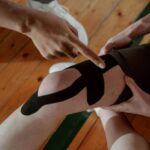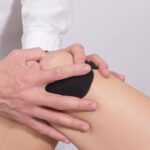Knee pain on the inside, also known as medial knee pain, is a common complaint among runners. It stems from a variety of potential causes, ranging from acute injuries to chronic conditions. Running, with its repetitive impact, places significant stress on the knee joint and its supporting structures. Over time, this can lead to inflammation, degeneration, or injury of the knee’s internal components, such as the medial meniscus or the medial collateral ligament.
Diagnosis and management of medial knee pain require a careful consideration of the runner’s history, symptoms, and physical findings. Commonly, runners report pain that is localized to the inner aspect of the knee which may be associated with swelling, stiffness, or a feeling of instability. While rest and ice can provide immediate relief, addressing the underlying cause and engaging in appropriate rehabilitation exercises are essential for long-term recovery and prevention of recurrence.
Treatment strategies typically include strengthening and stretching exercises to support knee stability, adjustments to running technique, and footwear modification. For some runners, particularly those with more serious injuries such as meniscus tears, medical interventions or even surgery may be necessary. It is crucial for individuals experiencing medial knee pain to consult healthcare professionals to devise a personalized treatment plan.
Understanding Knee Pain in Runners
Experiencing knee pain can significantly impact a runner’s ability to perform and enjoy their sport. This section discusses the structure of the knee and common sources of inner knee discomfort among runners.
Anatomy of the Knee
The knee is a complex joint that bears a significant amount of the body’s weight and allows for fluid movement. It consists of bones, such as the femur (thigh bone), tibia (shinbone), and patella (kneecap), which collaborate with soft tissues like ligaments, tendons, and cartilage to function properly. The knee’s stability and flexibility rely heavily on these components working in harmony. Among the most critical structures within the knee are the menisci, two C-shaped pieces of cartilage that act as shock absorbers between the femur and tibia, and the patellofemoral joint, where the patella and femur connect.
Common Causes of Inner Knee Pain
Inner knee pain, often felt on the inside aspect of the knee closest to the other knee, can arise from various issues related to running:
- Medial Meniscus Injuries: Stress from running can tear the medial meniscus, causing localized pain, swelling, and sometimes a popping sensation.
- Ligament Strains: The medial collateral ligament (MCL) is susceptible to injury from overuse or trauma.
- Pes Anserine Bursitis: Inflammation of the bursa located between the shinbone and three tendons of the hamstring can lead to inner knee pain.
- Patellofemoral Pain Syndrome (PFPS): Also known as runner’s knee, it’s a discomfort or pain around the kneecap and the patellofemoral joint, aggravated by running, squatting, and after sitting for extended periods.
Running can exacerbate these conditions, especially if there is improper form, inadequate footwear, or insufficient recovery time. It’s crucial for runners to listen to their bodies and consult with healthcare professionals if knee pain occurs.
Diagnosing Running Knee Injuries
The correct diagnosis of knee injuries from running is critical in developing an effective treatment plan. It involves evaluating symptoms rigorously, and potentially seeking medical consultation to identify the exact injury, which may include patellar tendinitis, bursitis, or a meniscus tear.
Symptoms to Watch For
Runners experiencing medial knee pain should monitor for common indicators of injury. Symptoms often include:
- Pain: Especially around the inner side of the knee that may worsen with activity.
- Swelling: This could be localized to a specific part of the knee or involve the entire area.
- Popping Sensations: A sign that could indicate a meniscus tear, particularly during the incident.
- Stiffness: Difficulty in moving the knee after periods of inactivity may also suggest injury.
- Instability: A feeling as if the knee might give way.
When to See a Doctor
While minor discomfort may often be alleviated with rest, certain symptoms necessitate prompt medical attention. They should seek out a healthcare professional when:
- Persistent Pain: Pain that does not improve with rest.
- Intense Swelling: Sudden swelling that arises immediately after injury or running.
- Limited Mobility: Inability to move the knee through its full range of motion.
Diagnostic Tests: A physician might utilize diagnostic tools such as:
- X-ray: To evaluate the bones of the knee joint for fractures or degenerative changes.
- Ultrasound or MRI: These imaging tests help in inspecting soft tissues, including muscles, tendons, and ligaments.
The physical therapist or doctor will perform a thorough physical examination and may recommend imaging tests, such as an x-ray or ultrasound, to confirm the presence of specific conditions such as tendinitis, bursitis, or a meniscus tear.
Prevention and Pre-Run Preparation
A runner’s approach to pre-run preparation is critical in preventing knee pain. Focus on correct running form and selecting appropriate footwear with adequate support to mitigate stress on the knees.
Proper Running Form
Running form is fundamental in reducing the risk of knee pain. Runners should maintain a straight posture with a slight forward lean and ensure their knees are in line with their feet during each stride. They should also avoid overstriding, as this can increase the impact on the knees. Strength training exercises such as squats and lunges can help build the muscles that support proper form.
Footwear and Support
Running shoes play a significant role in avoiding knee injuries. It is essential that a runner chooses shoes that match their gait and provide adequate arch support. For some, orthotics may be necessary to correct foot imbalances that contribute to knee pain. A routine of regular stretching and exercises like hamstring bridges can enhance stability and flexibility, offering additional internal support during running.
Effective Treatment Options
The alleviation of pain from inside knee injuries incurred during running focuses on immediate relief and long-term recovery. Adhering to recommended treatments ensures a safer and quicker return to running.
R.I.C.E. Method
- Rest: Crucial for the healing process, resting the injured knee prevents further strain and gives tissues time to recover.
- Ice: Applying ice reduces swelling and numbs pain. It’s most effective when used for 10-15 minutes multiple times a day soon after the injury occurs.
- Compression: This involves wrapping the injured knee to prevent additional swelling.
- Elevation: Keeping the knee elevated above heart level diminishes swelling by promoting fluid return towards the core.
Medications and Injections
- Ibuprofen: As an anti-inflammatory medication, ibuprofen can ease pain and decrease inflammation.
- Steroid Injection: Administered by a healthcare professional, steroid injections may be used to provide short-term pain relief for severe inflammation.
Surgical Considerations
When conservative treatments such as physical therapy do not yield desired results, surgery may be considered. It’s important for individuals to discuss the potential risks and benefits of knee surgery with a qualified orthopedic surgeon.
Rehabilitation and Strengthening
Rehabilitation and strengthening are vital components in resolving knee pain from running. They address muscle weaknesses and imbalances that can contribute to discomfort and injury.
Targeted Knee Exercises
Targeted knee exercises aim to fortify the muscles directly supporting the knee joint, such as the quadriceps and hamstrings.
- Quadriceps Strengthening: Patients can perform straight leg raises to reinforce these critical front-thigh muscles. Lie flat on the back, one knee bent, and the other leg straight. Lift the straight leg about 6 inches off the ground, hold for a few seconds, then lower it back down.
- Hamstrings Exercises: Hamstrings curls are effective for the back-thigh muscles. Stand and bend one knee as if trying to kick the buttocks, then slowly return to the starting position.
Building Core and Hip Stability
A strong core and stable hips are essential for reducing the load on the knees during running.
- Core Exercises: Planks can enhance core strength. Lie face down and prop the body up on the forearms and toes, keeping the body straight. Maintain this position.
- Hip and Glute Strengthening: Side-lying leg lifts help bolster hip abductor and glute muscles. Lie on one side, legs stacked. Lift the upper leg toward the ceiling, then lower it back down with control.
Understanding and Managing Chronic Conditions
Chronic knee pain in runners often stems from underlying conditions such as arthritis or patellofemoral pain syndrome, more commonly known as runner’s knee. Effective management of these conditions requires a combination of lifestyle modifications, medical interventions, and, in some cases, surgical options.
Dealing with Arthritis
Arthritis, including osteoarthritis, is a common cause of chronic pain inside the knee for runners. It is characterized by the degeneration of joint cartilage and the underlying bone. A systematic review of arthritis management suggests:
- Medication: To manage pain and inflammation, nonsteroidal anti-inflammatory drugs (NSAIDs) may be recommended.
- Physical Therapy: Strengthening and flexibility exercises can help maintain knee function and alleviate pain.
- Supportive Devices: Knee braces or orthotics can provide extra support and reduce strain on the joint.
Long-term Management of Runner’s Knee
Runner’s knee, or patellofemoral pain syndrome, is characterized by pain around the kneecap and is commonly experienced by runners. Long-term management strategies include:
- Exercise: Quadriceps strengthening can help improve patellar tracking and reduce pain.
- Rest: It is crucial to avoid activities that exacerbate the pain, allowing time for healing.
- Surgical Intervention: In severe cases where conservative treatments fail, surgery may become an option for pain relief and functional improvement.
Advanced Therapies and Supportive Devices
When addressing knee pain in runners, advanced therapies and supportive devices play crucial roles in both treatment and prevention. These methods complement traditional treatments by providing enhanced stabilization and targeted therapeutic interventions.
Bracing and Orthotic Solutions
Braces are a cornerstone for managing knee pain, particularly those designed for patellar stabilization and medial/lateral support. The DonJoy Lateral J Patella Knee Support Brace Without Hinge is noted for its efficacy in stabilizing the kneecap. It is especially beneficial for runners with lateral knee pain. For athletes with larger physiques, the Shock Doctor Compression Knee Brace is tailored to provide firm compression while accommodating a wider range of leg sizes.
Moreover, orthotics go hand-in-hand with braces, focusing on correcting foot and leg alignment which, in turn, can alleviate undue stress on the knee. Custom orthotics are often recommended to ensure an optimal fit and maximum benefit.
Innovations in Physical Therapy
Physical therapy has advanced with the introduction of specialized manual therapy techniques and personalized rehabilitation programs. These innovations aim to improve joint mobility, strengthen surrounding muscles, and enhance overall knee function, reducing the likelihood of injury recurrence. Manual therapy includes hands-on techniques such as massage and mobilization to reduce pain and improve movement range.
Furthermore, tailored exercise programs developed by physical therapists are critical. They focus on strengthening and flexibility exercises that provide targeted support to the knee joint, reduce pain, and prevent future injuries.
Return to Running: Guidelines and Tips
Before lacing up your running shoes after experiencing knee pain, it’s crucial to ensure that your knee has recovered sufficiently and to approach your return to running with a well-structured and incremental plan.
Assessing Knee Recovery
The first step towards resuming running is to thoroughly assess the recovery of the knee. Runners should be able to walk for 30 minutes without pain as an initial indicator of readiness. Additionally, tests such as single-leg squats and 60-second hopping drills at a specified tempo can help gauge stability and pain response. Rest is paramount; if pain presents itself during recovery exercises, it indicates the need for further healing.
Gradual Reintegration of Activity
Once the knee shows signs of proper recovery, a gradual reintroduction of running is advised. The 10% rule, which posits not to increase running time or mileage by more than 10% per week, is a practical guideline to follow. Incorporating rest days is essential to avoid overstressing healing tissues. Furthermore, runners should include exercise and stretching routines that target strength and flexibility, alongside practicing good running mechanics, to support knee function and prevent future injuries. Implementing softer surfaces and avoiding excessive downhill running can also protect the knee during the transition back to running.
| Tips for Safe Return to Running |
|---|
| Walk before you run |
| Follow the 10% rule |
| Incorporate rest days into your routine |
| Perform exercises and stretching |
| Monitor and correct running mechanics |
Consistent monitoring and incremental adjustments will help ensure a safe and successful return to running, minimizing the risk of re-injury.








